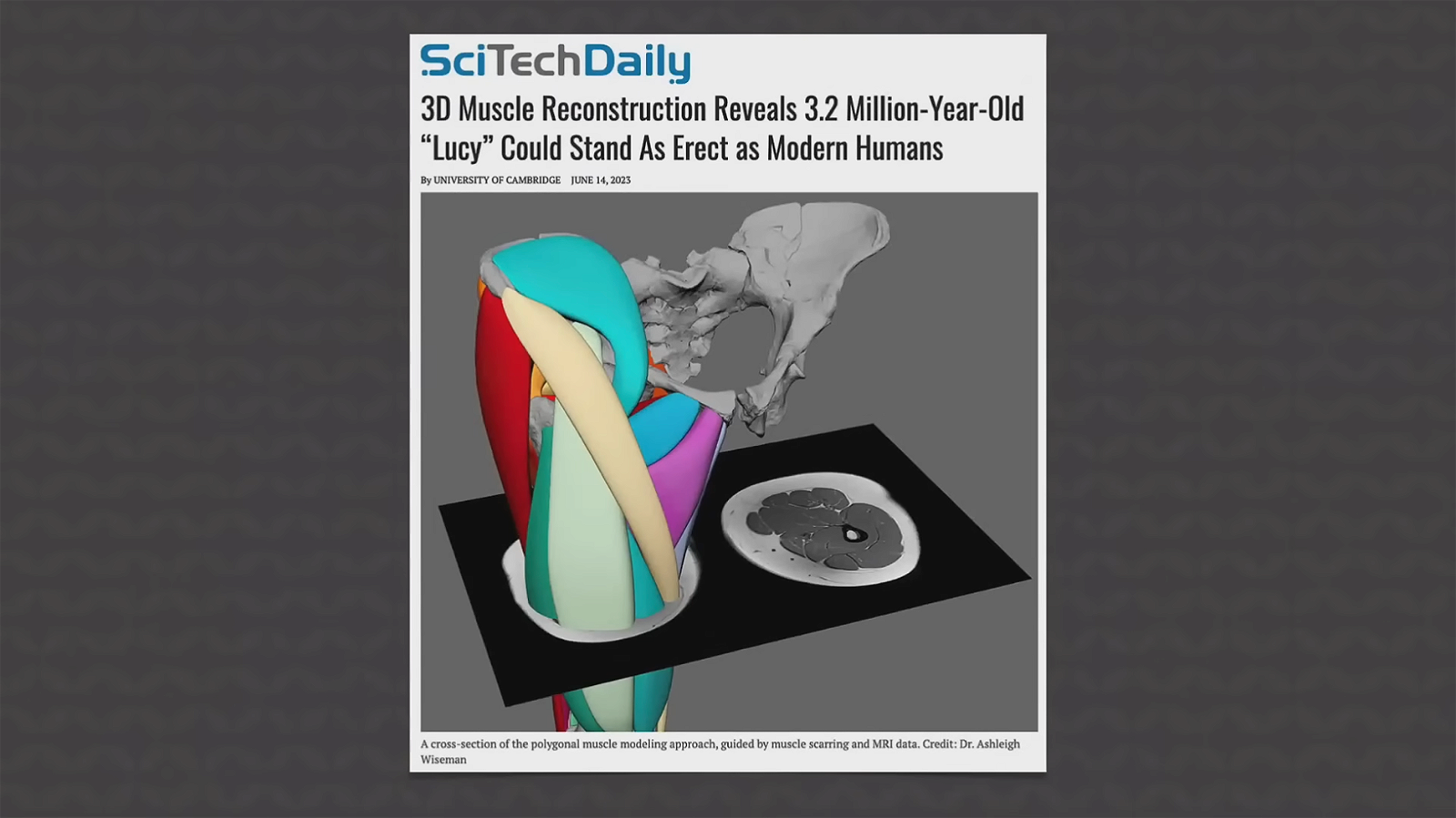
Could Supposed Ape-Woman Lucy “Stand as Erect as Modern Humans”?
“3D Muscle Reconstruction Reveals 3.2 Million-Year-Old ‘Lucy’ Could Stand As Erect as Modern Humans,” popular science headlines declare as they report on a new study on our supposed human ancestor, “Lucy.” But there’s more to the story than the headlines proclaim!
Of course, headlines in news stories are often constructed as “click bait,” aiming to be sensational to draw people in. But once one reads the actual scientific paper the news article is based on, one often finds it’s not as is claimed or there are assumptions that have biased the results in a particular way.
Lucy is the common name given to the fossils of a creature called Australopithecus afarensis. This find of a 40% complete skeleton in the mid-1970s was hailed a “missing link,” and Lucy has been considered a hominin (a human relative) ever since. Over the decades, however, scientists have argued about how “humanlike” or “apelike” she was, with debate raging around her ability to walk upright like humans. Has this new study ended the debate once and for all? Not so fast.
The study used computers (and remember, computer models always have parameters put in place by the researchers and affected by their worldview!) to reconstruct how her leg muscles might have looked and attached. Based on the results, the researchers concluded that:
Lucy’s muscles suggest that she was as proficient at bipedalism as we are, while possibly also being at home in the trees. Lucy likely walked and moved in a way that we do not see in any living species today.
In a biblical worldview we understand that Lucy is not a human ancestor.
Now, of course, in a biblical worldview we understand that Lucy is not a human ancestor. This creature isn’t even a “hominin” (an evolutionary category). There are apes and there are humans, and there is nothing in between. Based on her skeleton, we know Lucy was an extinct variety within the ape kind. So what do we make of this new study?
Well, first we must note something important about the methodology of the study:
Finally, muscles were layered on top, based on pathways from modern human muscle maps. . . .
Yes, they used human muscle maps to try to map out the muscles of a member of the ape kind! If their presuppositions regarding human evolution and how closely related we are to so-called hominins are wrong (and they are), then this entire study is flawed because they are using the wrong type of muscle map in the study!
It’s also worth noting that the study itself expresses the findings much less strongly than the popular science articles do, ending in the “Conclusion” part of the study with:
On the basis of the muscle leverage results, Au. afarensis was capable of producing an erect posture but was also capable of using the limb in a repertoire of motions beyond habitual terrestrial bipedalism, in a similar manner to chimpanzees and bonobos. As it stands, these results cannot confirm if AL 288-1 was an efficient biped, but rather that upright walking was a possibility.
What we do know for sure is that apes remain apes and humans remain humans.
In a biblical worldview, we understand God may have created the genetic diversity in the ape kind to allow some apes to stand more upright. But based on what we know about apes (and Lucy), this seems unlikely, so I am wary of this particular study’s results (especially considering they used a human muscle map!). But what we do know for sure is that apes remain apes and humans remain humans, both created by God fully formed and functioning on day six of creation week just a few thousand years ago.
Get More Answers on Answers News
This item was discussed Monday on Answers News with cohosts Dr. Georgia Purdom, Rob Webb, and Bryan Osborne. Answers News is our weekly news program filmed live before a studio audience here at the Creation Museum, broadcast on our Answers in Genesis YouTube channel, and posted to Answers TV. We also covered the following topics:
- Should AI write sermons?
- Water vapor in an asteroid belt?
- Quebec, Canada, seeks to expand euthanasia . . . again!
- And more!
Watch the entire episode of Answers News for June 19, 2023.
Be sure to join us each Monday at 2 p.m. (ET) on YouTube or later that day on Answers TV for Answers News. You won’t want to miss this unique news program that gives science and culture news from a distinctly biblical and Christian perspective.
Thanks for stopping by and thanks for praying,
Ken
This item was written with the assistance of AiG’s research team.
Most Recent News
-
Dec. 23, 2025 from Ken Ham Blog
A recent news item caught my eye when I saw the headline: “18,000 dinosaur tracks discovered along ancient Bolivian coastline.”
-
Dec. 22, 2025 from Ken Ham Blog
“Why should God have anything against there being four of them rather than two?” is the question a clergywoman in Germany asked recently.

Answers in Genesis is an apologetics ministry, dedicated to helping Christians defend their faith and proclaim the good news of Jesus Christ.
- Customer Service 800.778.3390
- Available Monday–Friday | 9 AM–5 PM ET
- © 2025 Answers in Genesis



